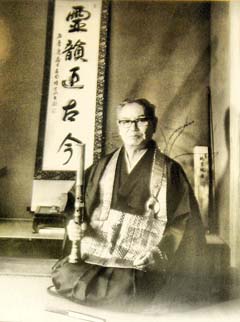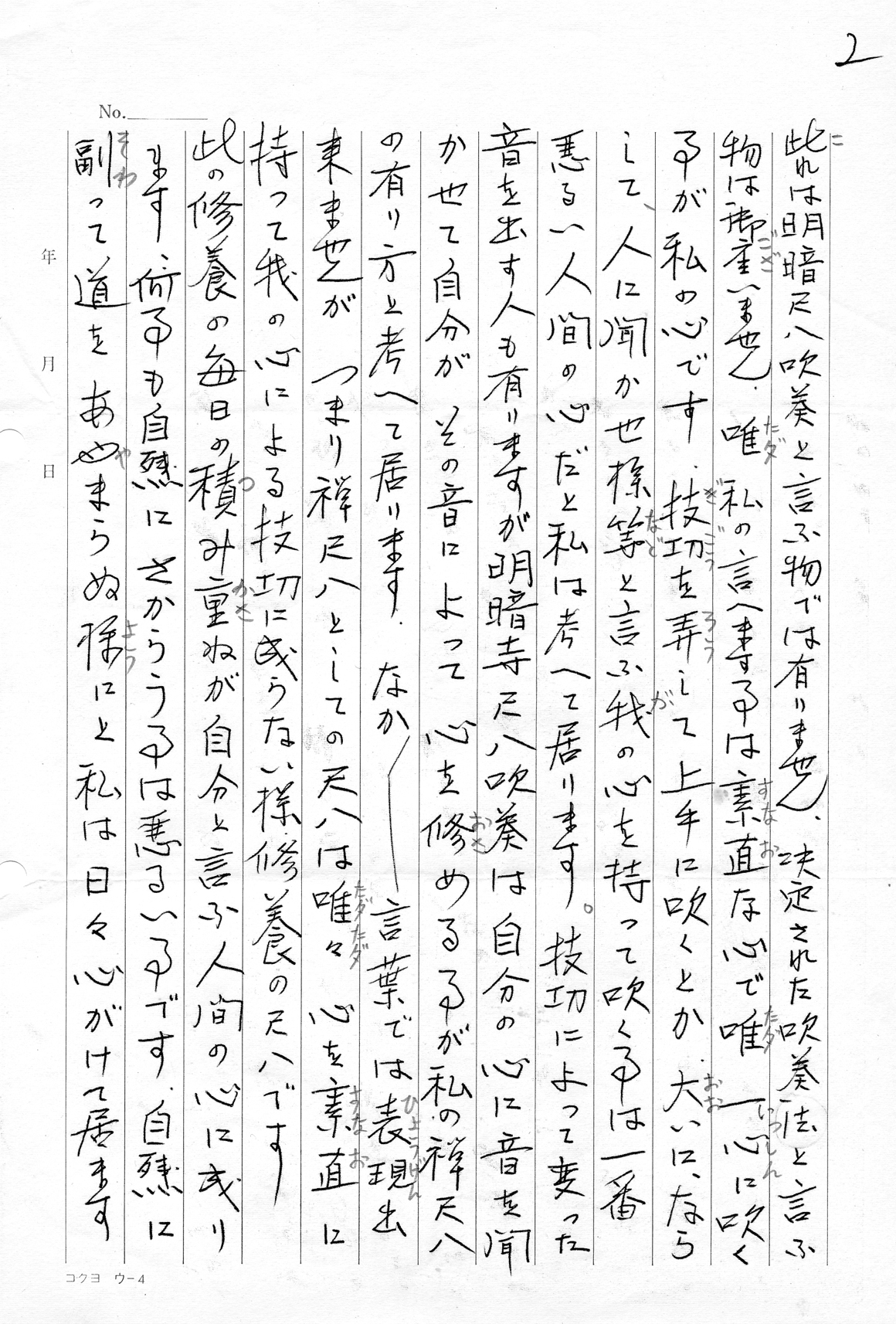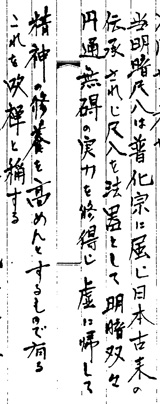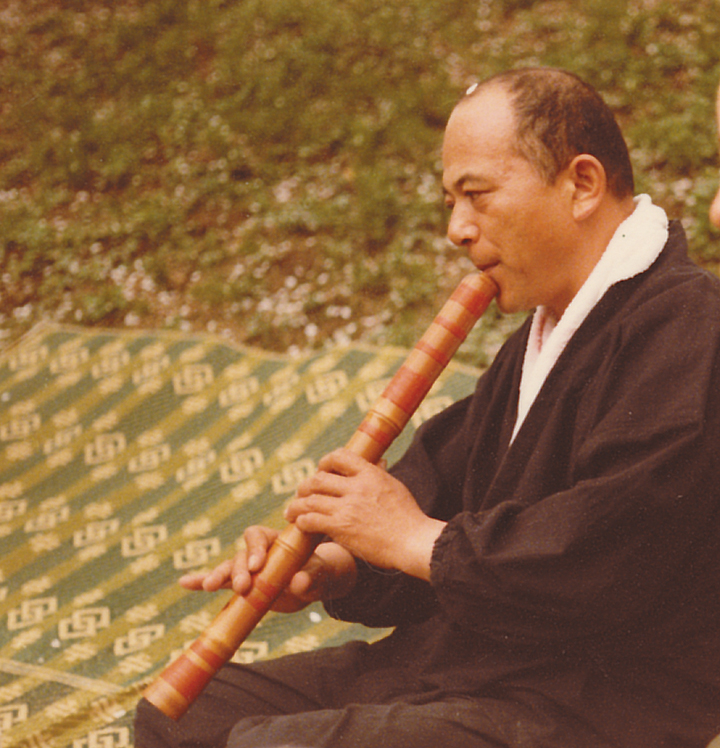|
1977 & 1978: The Sincerity of the Late Myōan Taizan-ha
'Suizen' Players/Teachers Yoshimura 'Fuan' Sōshin
& Ozawa 'Zetsugai' Seizan - and Hisamatsu Fūyō's
Heartfelt Ascetic Shakuhachi Credo 200 Years Ago
禅尺八 - 'ZEN SHAKUHACHI'
修養の尺八 - 'SHŪYŌ no SHAKUHACHI'
"The Shakuhachi of Self-cultivation and Self-discipline"
The 1970s' Myōan Taizan-ha Way of Authentic Shakuhachi 'Suizen' Asceticism
represented by Yoshimura Fuan Sōshin, 40th 'Kansu' of Kyōto Myōan-ji.
明暗寺四十世 芳村普庵宗心
MYŌAN-JI YONJŪ-SE YOSHIMURA FUAN SŌSHIN

Yoshimura Fuan Sōshin - 1904-1998
1977, August 9 - YOSHIMURA 'FUAN' SŌSHIN:

Yoshimura Fuan Sōshin's letter to Torsten Olafsson, August 9, 1977, page 2
此れは明暗尺八吹奏と言ふ物でわ有りません。
決定された吹奏法と言ふ物は御在いません。
唯、私の言えまするは素直な心で、
唯、一心に吹くるが私の心です。
技功を弄して、上手に吹くとか、
大いにならして、人に聞かせ様等
と言ふ我の心を持って吹くるは
一番悪い人間の心だと
私は考えて居ります。
技功によって変わった音を出す人も有りますが、
明暗寺尺八吹奏は自分の心に音を聞かせて
自分がその音によって、心を修めるるが
私の禅尺八の有り方と考えて居ります。
なかなか言葉では表現出来ませんが、
つまり禅尺八としての尺八は唯々
心を素直に持って, 我の心による
技功に成らない様、修養の尺八です。
此の修養の毎日の積み重ねが
自分と言ふ人間の心に成ります。
何るも、自然にさからうるは悪いるです。
自然に副って、道をあやまらぬ様にと
私は日々心がけて居ります。
"Myōan Shakuhachi can not be likened to the playing of an ordinary wind instrument.
Such thing as a fixed way of playing does not exist.
What I can say is, plainly, that I am only concerned with directing my blowing
towards my own Self - with a gentle mind.
It is my opinion that people who trifle with skill of playing and "play well"
- who exercise exceedingly intending to impress the listener and the like -
that way of blowing with an egocentric mind represents the worst of human attitudes (that I can think of).
There are people who produce changing sounds depending on technical skill,
but as for the shakuhachi practice of the Myōan Temple,
I believe that the ideal way of Zen Shakuhachi
is to let one's true Mind listen to the sounds and to cultivate one's own Self
in accordance with those sounds.
I can not easily express this in words but to practice the shakuhachi of 'Zen Shakuhachi' is indeed a way of mental training and self-cultivation that is practiced
with an open and humble mind and does not develop into technical skill with a selfish attitude.
The accumulation of this daily practice will, eventually,
bring about the realization of the true Self of one's Human Nature.
It is, in any case, wrong to act against Nature.
I am devoting myself every day to follow Nature and not to be mistaken about the Way."
Yoshimura Fuan Sōshin, Myōan-ji, August 9, 1977.
Private correspondance. Trsl. by Torsten Olafsson.
Read more about Yoshimura Sōshin at www.komuso.com, link:
https://www.komuso.com/people/people.pl?person=982
明暗尺八 - MYŌAN SHAKUHACHI
明暗雙雙 - MYŌAN SŌSŌ - "The Myōan Pair"
法器 - HŌKI - "Instrument of the Buddhist Law"
小沢絶外盛山
1978 - OZAWA 'ZETSUGAI' SEIZAN

Detail of a letter of recommendation for T.O.
written by Ozawa Seizan in Spring, 1978
See translation below ...
当明暗尺八は、普化宗に属じ日本古耒の伝承されじ
尺八お法器として、明暗双々円通無碍の実力を修得じ、虚に帰して、精神の修養を高めんとするしので有る。
これを吹禅と稱する。
"Myōan Shakuhachi is related to the Fuke Sect of Shakuhachi and it has as its purpose to employ the ancient Japanese shakuhachi flute as a Dharma instrument [hō-ki]
in order that one understands the Ultimately Adual Nature of the 'Bright' and the 'Dark' [Myō-An] and experiences the Essence of Non-substantiality
[kyo] through Self-Cultivation.
This [practice] is called 'Suizen'."
By Ozawa Seizan, 1939-2012, Myōan-ji, 1978, in a letter
of recommendation to the author. Trsl. by Torsten Olafsson.

Ozawa Seizan Sensei, 1939-2012
Photo: Torsten Olafsson, Spring, 1978
Read more about Ozawa Sensei at www.komuso.com, link:
https://www.komuso.com/people/people.pl?person=1617
An INTERESTING BACKGROUND PERSPECTIVE:
In a publication dated 1818, titled Hitori-goto,
独言,
Hisamatsu Fūyō, 1791-1871, a renowned representative of the early Kinko-ryū Shakuhachi tradition,
expressed the following:
「初心より美敷音のむまみを修行すべからず、
音艶むまみは出来るを好んで出かすを嫌ふ。」
'Shoshin yori, utsukushiki oto no mumami o shugyō subekarazu.
Ne-en mumami wa dekiru kononde, dekasu o kirau.'
"From the beginning (lit. with a beginner's intention), do not (ascetically) practice
the "tastefulness of a beautiful sound".
I dislike it when people please themselves with putting out tasteful "sound gloss"."
Trsl. by T.O.
That is what Hisamatsu Fūyō expressed in humble writing at the time when the ‘Kinko-ryū’ tradition of shakuhachi asceticism had not yet changed,
metamorphosed, into a sophisticated, technically demanding "shakuhachi 'honkyoku' concert performance art form".
In 1983, Andreas Gutzwiller published this translation in German, in his book "Die Shakuhachi der Kinko-Schule”:
"Man darf nicht von Anfang an danach streben, einen schönen Ton zu erlangen,
und es ist verdammenswert, wenn jemand es liebt, einen glanzvollen Ton hervorzubringen."
Wolfgang Fuyūgen Heßler presented his English translation like this:
"One must not deliberately strive from the beginning to achieve a beautiful tone.
It is disgraceful when someone loves to produce a splendid tone."
Source: http://komuso.ch/?page_id=313&lang=en
And, in 2010/8, Matt Treyvaud contributed with this rendering of his in English:
"As a beginner, do not strive for the (m)umami of beautiful sound.
It is pleasing when polish and (m)umami emerge from (dekiru) the sound;
to force them out (dekasu) is disagreeable."
Source: http://no-sword.jp/blog/2010/08/umami.html
By the way, Matt Treyvaud also cited Hisamatsu-san for this exchange of his
in the 1823 Hitori-mondō,
独問答:
問 普化禅師はいかなる人ぞ
答 知らず禅家の知識に問へ
"Q: What kind of person was Master P'ǔ-huà [Fuke] ?
普化?
A: I don't know. Ask a scholar at a zen temple."
In other words, we should probably surmise that Hisamatsu-san was not himself a Zen monk.
Nor, that he was himself a 'komusō'.
|
|




